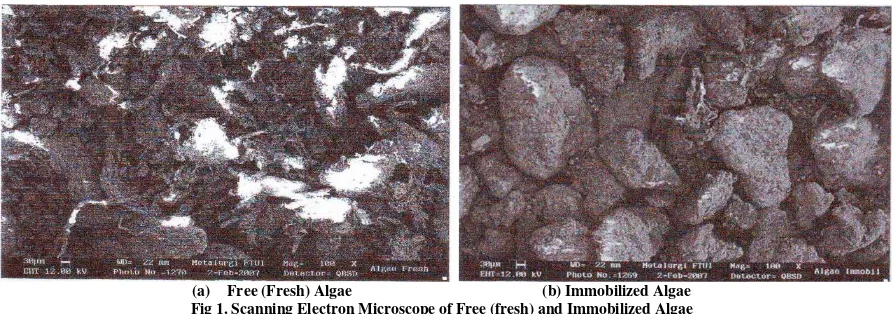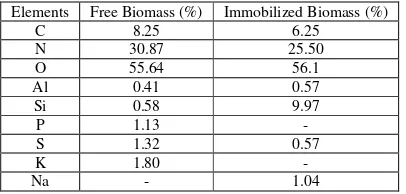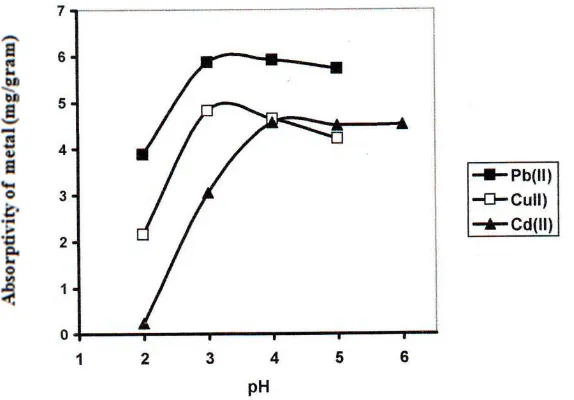Journal of Chemical and Pharmaceutical Research, 2015, 7(11):715-722
Research Article
CODEN(USA) : JCPRC5
ISSN : 0975-7384
Study of Pb(II) biosorption from aqueous solution using immobilized
Spirogyra subsalsa b
iomass
Mawardi Anwar
1*, Edison Munaf
2, Soleh Kosela
3, Widayanti Wibowo
3and Rahadian Zainul
41Laboratory of Analytical Chemistry, Faculty of Mathematics and Science, Padang State University, Padang, Indonesia
2Laboratory of Analytical Chemistry, Faculty of Mathematics and Science, Andalas University, Limau Manis, Indonesia
3
Laboratory of Chemistry, Faculty of Mathematics and Science, Indonesia University, Depok, Indonesia 4
Laboratory of Photoelectrochemistry, Padang State University, Air Tawar, Indonesia
_____________________________________________________________________________________________
ABSTRACT
The immobilized biomass of green algae Spirogyra subsalsa was used as biosorbent for removal of lead (II) from aqueous solution. The effects of operating parameters, such a flow rate, influent pH and influent metals concentration were investigated. Significantly, the immobilized biomass showed IR spectrum not difference with free algae biomass. The biosorption process were a repaid process, where in more than 50% of the final uptake value occur at rate flow 1.5 mL/minute. The biosorption capacities of biomass for cations increase rapidly with pH between 2,0-3,0 then the maximum sorption was seen at pH 4,0. The biosorptive capacity increased with initial concentration in the range 50-200 mg/L. A comparison of the biosorption of Pb2+ cation by immobilized and free algae biomass showed an increase in uptake of over 4,25%. The immobilized biomass could be regenerated using nitrate acid, HNO3, and significantly proportional with using nitrate acid concentration, with up to 89 % Pb2+ recovery by 0,5 M HNO3. This study suggests that such an immobilized biosorbent system has the potential to be used in the industrial removal and recovery of Pb2+ cation from aqueous solution.
Keywords: S. subsalsa, biosorption, desorption, sodium silicate, nitrate acid
_____________________________________________________________________________________________
INTRODUCTION
Recent industrialization in coastal regions has increased the discharge of industrial wastes, especially those containing heavy metals, into environmental. Industrial and mining effluents can contain extremely high concentrations of metals. These contaminants have been found to be some of the most toxic pollutants. Continued anthropogenic input of metals into the natural waterways environment has increased the concentrations of these metals to alarming levels. Thus, the effect of heavy metals on the natural waterways ecosystem are of particular interest because metals persist without degradation[1].
methods, much interest has been created in the recovery or removal of heavy metal ions from waste water using microorganism or bio-materials [2,5]. Microorganism including bacteria, algae, fungi, and yeast can efficiently accumulated heavy metals and radio nuclides from their external environment.
Biosorption may be defined as the process of metabolism-independent binding or adsorption of metal ion or metalloid species, compounds and particulates from solution by biological material (biomass), which occurs mainly by physicochemical mechanism such as ion exchange, complexation and adsorption. Metals uptake by biomass are believed to occur through sorption process involving the functional groups associated with biopolymers protein, nucleic acid, polysaccharides, lignin and other biopolymers found in the cell or cell walls, all provide sites at which metal ions will bind. The functional group as well as negatively charged groups such as Carboxylate, thiolate or phosphate and groups such as amine, hydroxide, imidazole function which coordinate to the metal center through lone pairs of electrons [1-5]. Among the various contact systems, recovery of metal from loaded biomass is still cumbersome. Researchers have recognized that immobilizing biomass in granular or polymeric matrix may improve biomass performance and facilitate separation of biomass from solution [6-8].
In this research was learned about biosorption Pb2+ cation by immobilized biomass within polysilicate matrix to absorption capacities. Optimum condition of biosorption inside the column (continue system) converting: rate of low, initial solution pH and initial concentration each cations. Optimum condition of regeneration column by nitrate acid, HNO3, and recovery column. Equilibrium adsorption isotherms Langmuir and Freundlich were obtained
quantitatively to describe the Pb2+ ions uptake in aqueous solution. Application to remove and preconcentration trace element form waste waters.
EXPERIMENTAL SECTION
Chemicals and reagents
All reagents employed in this work were of analytical reagent grade and obtained from E. Merck. The stock metal solution of Pb2+ ions were prepared by dissolving appropriate quantities of pure analytical grade metal salt Pb(NO3)2
in deionized water. The stock solution was further diluted with deionized water to obtain working solution of desirable concentration.
Biomass Of Spirogyra subsalsa
Fresh algal biomass of Spirogyra, subsalsa was collected from Air Dingin River Padang City, West Sumatera. Algae was identified in The Taxonomy Laboratory at Faculty of Mathematics and Science. Andalas University, Padang. Before use, biomass was washed with excess of pure water, dried at room temperature for a day , then ground and screened to particle 250 m. Biomass particle is rinsed with 1% nitrate acid, HNO3, and then with deionized water.
After the washing solution is discarded the algae biomass was dried at room temperature for 1 day, before use.
Immobilization of algae Spirogyra, subsalsa biomass
The method for immobilization of cell wall material within a polysilicate matrix was similar to that reported by Gardea [9]. A 5 g sample of biomass was washed twice by vortexing the sample with water and was centrifuged for five minutes at 3,000 rpm. This step will remove sol bubbles and debris. Next, 75 mL of 5% H2SO4 was mixed with
enough 6% Na2SiO3 solution to raise the pH 2.0. At pH 2.0, the 5 g of washed biomass was added to the silica
solution and allowed to stir for 15 minutes. The pH was then raised slowly by addition of 6% sodium silicate (Na2SiO3) to reach a final pH of 7.0. The polymer gel was washed with water enough times so that by the addition
of two drops of barium chloride (BaCl2) there was no white precipitate forming. BaCl2 was used to indicate whether
the sulfates had been removed. The polymer gel with the immobilized biomass was dried overnight at 60˚C.
Column Experiments
Desorption and Recovery of cations from column
To remove the bound cations, solution of HNO3 0.05-0.5 M was passed at a flow rate of 1,5 mL per minute. Each
bed volume was collected and metal ions concentration in solution analyzed by Atomic Absorption Spectrophotometer.
Analytical Procedure
Analysis for each metal cations was performed using a Perkin Elmer model AA100 Atomic Absorption Spectrometer with deuterium background subtraction. Impact bead was utilized to improve the sensitivity at a wavelength of lead(II) cation. Samples were read three times, and a mean value and relative standard deviation was computed. Calibrations were performed in the range of analysis, and a correlation coefficient for the calibration curve 0.8 or greater was obtained. The instrument response was periodically checked with known solution of metal ions standards.
Metal concentration in solution was measured by Atomic Absorption Spectrophotometer (AAS). Moreover, the degrees of biosorption in biomass were calculated by the difference between the initial metal concentration and the remaining metal concentration in effluents was assumed to be taken up by the biomass.
The quantitative of estimation was done by Langmuir isotherm as equation. The linearized from Langmuir equation is
1/qe = 1/(Qob Ceq) + 1/ Qo
In which Qois Langmuir constant which is measure of adsorption capacity in (mg/g) and b is the Langmuir constant
which measure of adsorption energy in (L/mg).
FTIR characterization of biomass.
To obtain a preliminary analysis of the main functional groups present on the wall of the free and immobilized biomass was analyzed using a Fourier Transform Infrared Spectroscopy (Shimadzu IR Prestige – 21, FTIR-84005, analytical instrumentation facility Andalas University, Padang, Indonesia) using KBr as the rock salt. The finely devided solid biomass was mixed with a disc using a hydraulic press and mould. The mixture of the disc was inserted in the path of the IR beam and held in position. IR spectra of free and immobilized of biomass in sodium silicate were recorded and the FTIR spectra obtain at range of 4000-400cm-1.
RESULTS AND DISCUSSION
Scanning Electron Micrographs of Immobilized Algae Cells
(a) Free (Fresh) Algae (b) Immobilized Algae Fig 1. Scanning Electron Microscope of Free (fresh) and Immobilized Algae
Figure 1 shows a series of scanning electron micrographs (SEM) images representing the surface of free and
total surface coverage support suggest that it may be possible to immobilize a greater quantity of algae cells. This could result in an increase in the adsorbing surface area of the biosorbent and consequently an increased capacity.
Spectra EDX Semi–micro Analysis
(a) (b) Fig 2. EDX Analysis of Free (Fresh) Algae (a) and Immobilized Algae (b)
Table 1. EDX Analysis of Element Composition of Free (Fresh) Algae and Immobilized Algae
Elements Free Biomass (%) Immobilized Biomass (%)
C 8.25 6.25
N 30.87 25.50
O 55.64 56.1
Al 0.41 0.57
Si 0.58 9.97
P 1.13 -
S 1.32 0.57
K 1.80 -
Na - 1.04
Spectra EDX semi-micro analysis of free and immobilized algae S. subsalsa biomass was showed that decreasing C, N, S and K of percentage element between free algae and immobilized algae. But, increasing of O, Al, Si and Na percentage element for algae and immobilized algae. The difference of element content is caused by spheric and surface construction which taken place of interaction between metal ion (Pb+2) and interface of adsorbant.
FTIR analysis
Fig 3. FTIR graph of Free Algae and Immobilized Algae
Effect rate of flow
Fig 4. Rate flow of Adsorbant to absortivity of Pb, Cu and Cd Metal Ion
Effect of initial solution pH
Fig 5. pH effect to absortivity of Pb, Cu and Cd Metal Ion
The result obtained, as showed in Figure 5, clearly showed that the biosorption of Pb (II) ion by Spirogyra subsalsa of biomass for cations increase rapidly with pH between pH 2,0 – 3,0 than the maximum sorption was seen at pH 4,0. It could be seen that at the pH lower than 2,0 there was small adsorption of cations, however as the pH of the solution was increased a rise in the adsorption of cations could be noticed, which peaked at pH 4,0.
The observation that metals ions sorption decrease under acidic conditions, probably because metal ions must compete with protons (hydronium ions) for ligand, and so metals bind less well at lower pH values as the potential donor groups, like carbonyl and amine groups become protonated, thus reducing the biosorption capacity. For these reasons, in this experiment, care was taken to use solutions of pH values within the range of 2 – 5. Values of pH above this range will cause precipitation of the lead (II) ion as hydroxides.
Effect of initial concentration cations
Konsentrasi (ppm)
Fig 6. The Concentration effect to absortivity of Pb, Cu and Cd Metal Ion
Effect regenerated using nitrate acid, HNO3 to remove and preconcentration trace element
Fig 7. Nitric Acid Concentration Effect to Absorptivity of metal ion
Effect regenerated using nitrate acid, HNO3 to remove and preconcentration trace element showing in Figure 7. The
immobilized biomass could be regenerated using nitrate acid, HNO3, and significantly proportional with used nitrate
acid concentration, with up to 89% Pb2+ recovery by 0,5 M HNO3
CONCLUSION
Significantly, the immobilized biomass showed IR spectrum not deference with free algae biomass. The biosorption process were a rapid process, where in more than 50% of final uptake value occur at rate flow 1,5 mL/minute. The biosorption capacities of biomass for cations increase rapidly with pH between pH 2,0-3,0 then the maximum sorption was seen at pH 4,0. This effect in pH suggests that the binding mechanism may be an ion exchange type process. The biosoprtive capacity increased with initial concentration in the range 50-200 mg/L.
A comparison of the biosorption of Pb2+cation by immobilized and free algae biomass showed an increase in uptake of over 4,25%. The immobilized biomass could be regenerated using nitrate acid, HNO3, and significantly
proportional with used nitrate acid concentration, with up to 89% Pb2+cationrecovery by 0,5 M HNO3. This study
suggests that such an immobilized biosorbent system has the tremendous potential to be used in the industrial removal and recovery heavy metals from aqueous solution and could have for cleansing the environment and industrial waste effluents from toxic metal ions.
REFERENCES
[1] Gad, F.M., 1990a, Biosorption, Chemistry & Industry,13:421-426
[2] Hancock, J.C, 1996a, in Symposium and Workshop on Heavy Metal Bioaccumulation, IUC Biotechnology Gadjah Mada University, Yogyakarta, September 18-20, 1996
[3] Chen,J.P., and Wang,L., 2004, Chemosphere, 54: 397-404
[4] Chergui, A., Bakhti M.Z., Chahboub,A., Haddoum,S., Salatnia,A. and Junter, G.A,2007, Desalination, 206,179-184
[5] Davis, T.A., Volesky, B and Mucci., A., 2003, Water Research, 37 ,4311-4330
[6] Chandra Sekhar, K, Kamala, c.t, Chary, N.S and Sastry A.R.K, 2004, Journal Hazardous Materials, b 108 (2004) 111-117
[10] Chergui, A., Bakhti M.Z., Chahboub, A., Haddoum. S., Selatnia, A. And Junter, G.A, 2007, Desalination, 206, 179-184
[11] Gadd, G. M., 1990, Biosorption, Chemistry & Industry, 13: 421- 642
[12] Gardea-Torresdey, J. L, Becker-Hapak, M.K., Hosea, J. M., and Darnall, D.W., 1990, Environ. Sci. Technol.,
24(9): 1372-1379
[13] Gardea-Torresdey, J.L., Gonzales, J.h., Tiemann, K.J.; and Rodriguez, O. 1996, University of Texas at El Paso, Dari http://[email protected]
[14] Mahan, C. A., and Holcombe, J. A., 1992, Anal.Chem, 64, 1933-1939
[15] Pravasant, P , Apiratikul, R., Sungkhum V., Suthiparinyanont P., Wttanachira S., and Marhaba, T.F., 2006,
Bioresource technology, 97, 2321 – 2329
[16] Ramelow, U. J., Neil Guidry, C. And Fisk, S. D., 1996, Journal of Hazardous Materials, 46, 37-55 [17] Volesky, B. and Hollan, Z.R., 1995, Biotechnol. Prog., 11, 235-250




